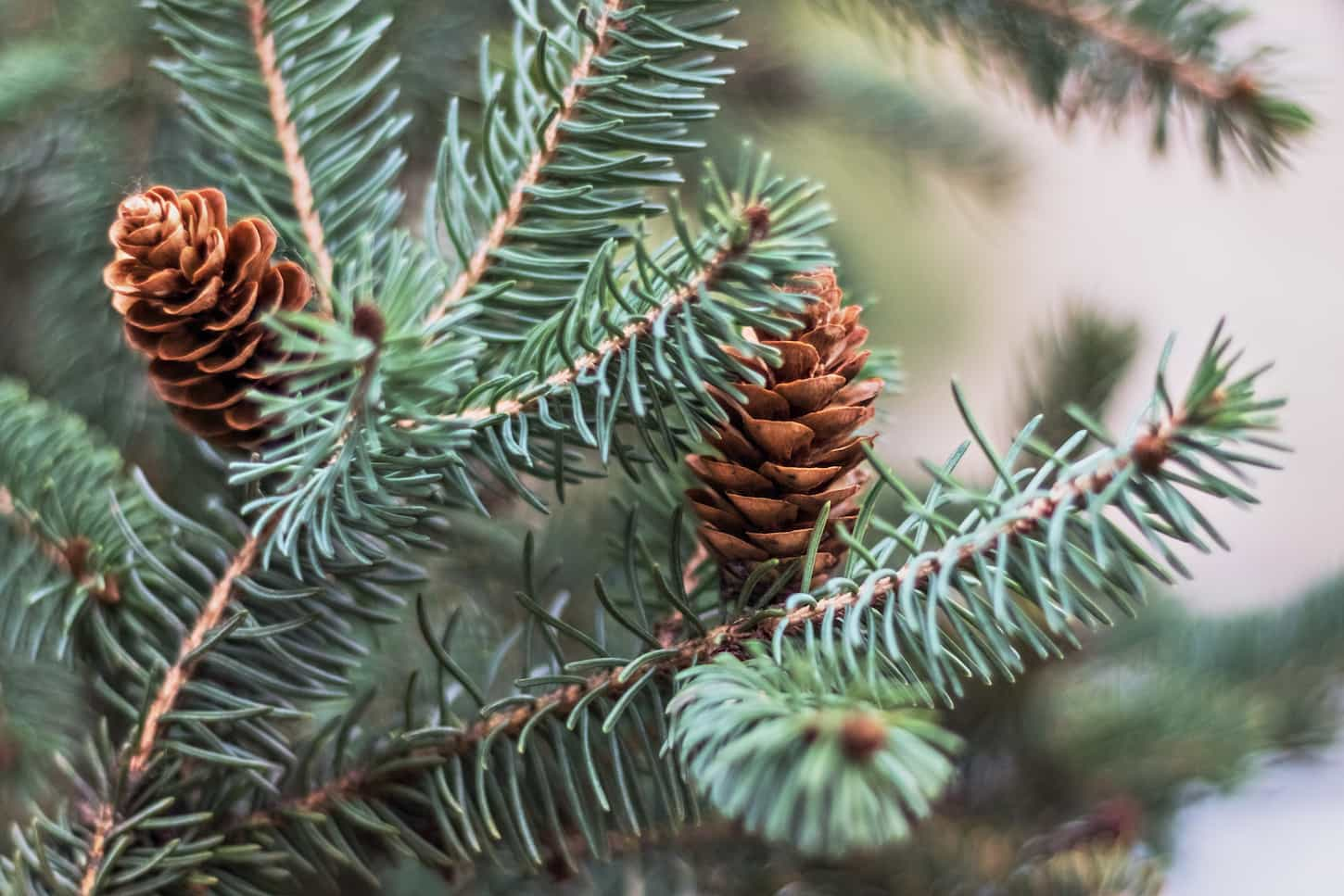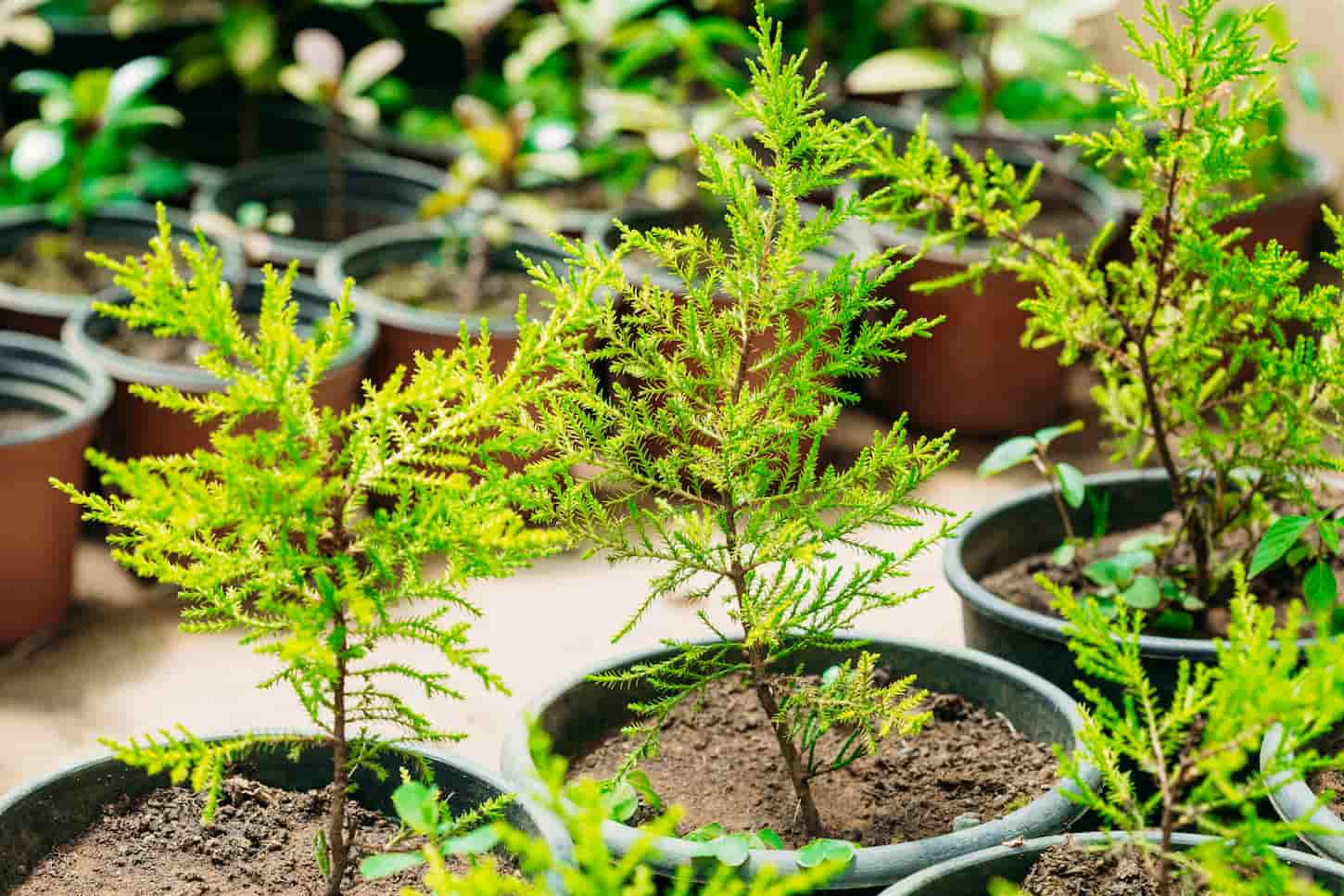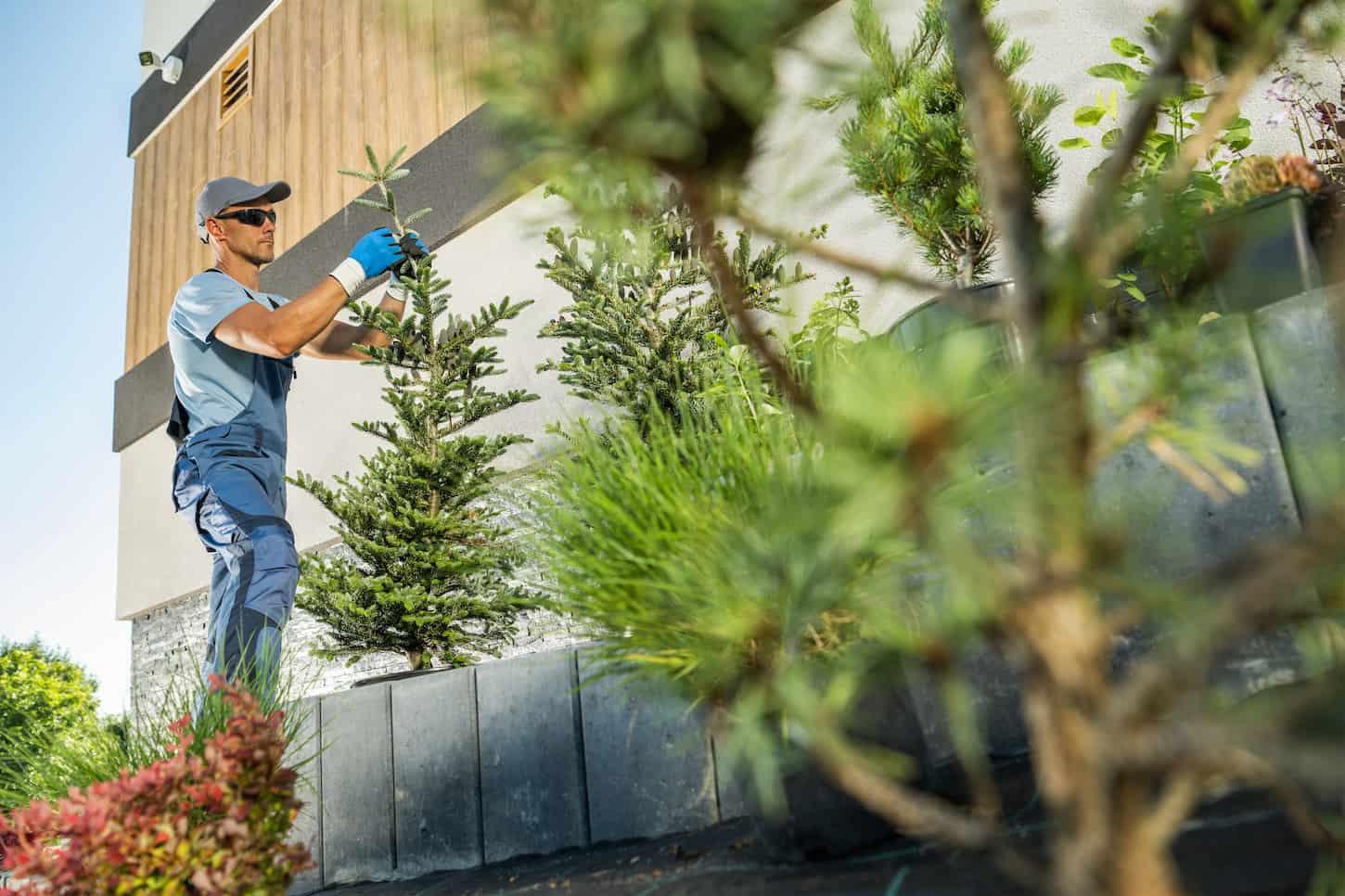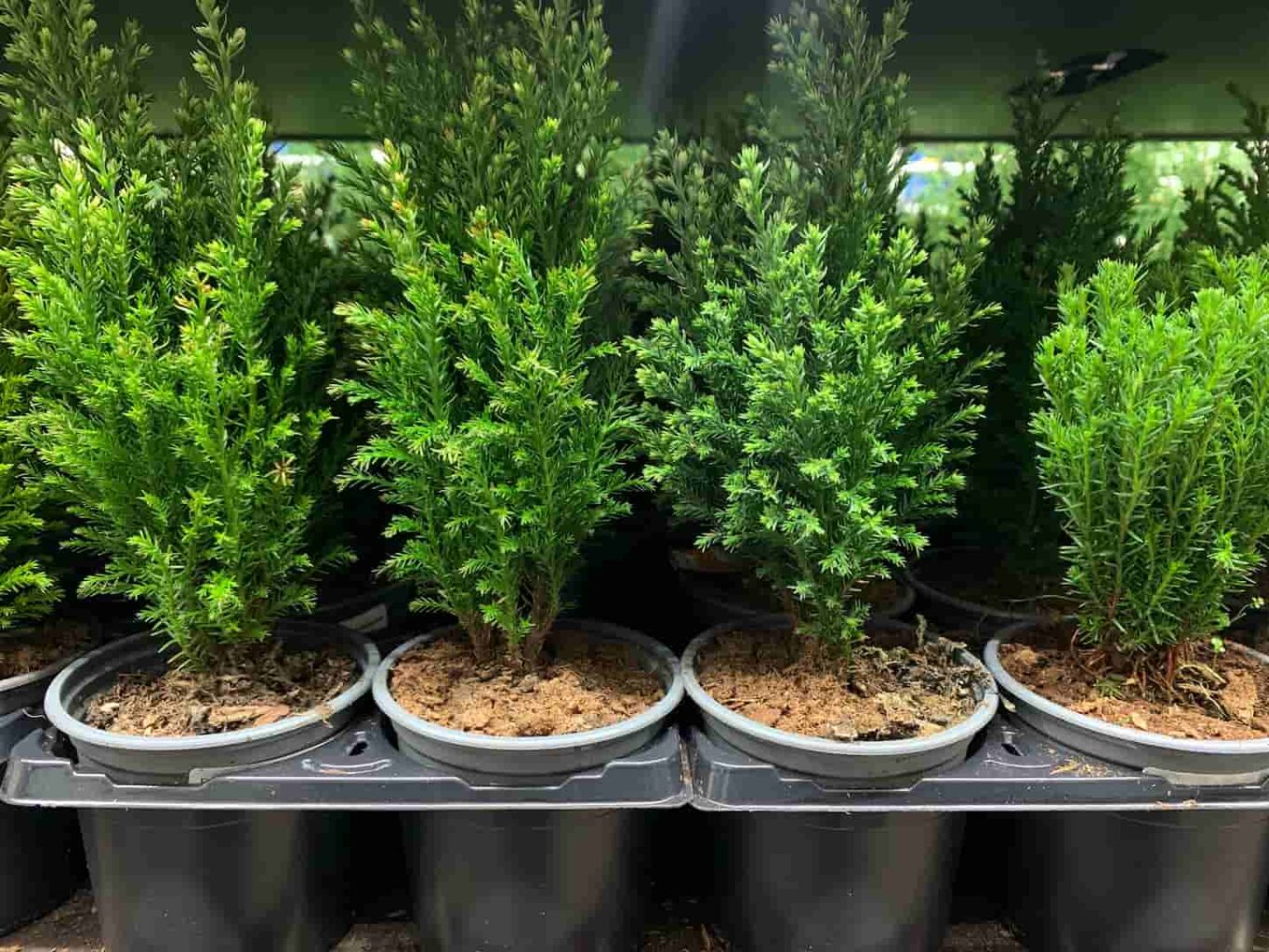The Blue Spruce (Picea Pungens) is a coniferous evergreen with a striking blue/gray tint and is one of the most popular garden trees in the USA. They are beautiful and make good privacy screens and windbreakers. So, which fertilizer should we use to keep them healthy?
The best fertilizer for blue spruce trees is a slow-release, evergreen fertilizer that promotes acidity and is low in phosphorus. Spruce trees need lots of nitrogen, so the best fertilizer is one with a 12-5-8 or 12-6-4 ratio.
Evergreens need less fertilizer than deciduous trees but still benefit from extra nutrients. The Spruce will look fuller and have a better color with the right fertilizer, while the wrong fertilizer could be bad for its health.
So, if you want to know what the best fertilizer is for Blue Spruce, check out the vital information below.

What is The Best Fertilizer for Blue Spruce?
Spruce trees are hardy and do not have complex nutritional needs, so a slow-release fertilizer is ideal. They need lots of nitrogen to develop foliage, so a high-nitrogen fertilizer is best for Blue Spruce.
The Blue Spruce can grow up to 60 feet in zones 2-7, and it’s easy to grow as long as we provide the correct nutrients. A well-nourished tree is healthier, hardier, and looks better, and with the right fertilizer, we can increase needle length and improve the color of a Spruce.
Fertilizers provide the soil with vital macronutrients that plants need to grow and thrive. Good, well-balanced soil is naturally full of nutrients, but the plants will deplete these over time. This is why we must replenish it with fertilizer.
The main thing to look out for in fertilizers is the NPK values. The NPK value represents the three most important nutrients for plants:
- Nitrogen (N) – Nitrogen helps plants with vegetative growth – shoots and leaves.
- Phosphorus (P) – Phosphorus helps roots develop and flowers grow.
- Potassium (K) – Potassium provides protein and helps plants with hardiness and disease resistance.
The NPK values are usually listed as a ratio, so 12:12:12 is an equal balance of all three. A high nitrogen fertilizer would be 12:5:8.
What Fertilizer Should I Use on My Blue Spruce?
Use evergreen fertilizer on a Blue Spruce unless the soil is poor or imbalanced. If the soil is not healthy, do a soil analysis to discover what nutrients are lacking, and fertilize it accordingly.
If the soil test shows that it’s low in nitrogen, pick a high-nitrogen fertilizer. A soil test will also show the pH level and the overall condition of the soil.
When choosing a fertilizer, there are two options, organic or synthetic.
Option #1 – Organic fertilizers
Organic fertilizers are made from natural ingredients and improve soil texture and quality over time. They promote biodiversity and improve the microbial content of the soil – which is healthier for both plants and the planet.
Organic plant food usually contains things like fish emulsion, alfalfa, or cottonseed meal for nitrogen – kelp or granite meal for potassium or rock phosphate or bone meal for phosphorus.
Organic fertilizers take longer to dissipate because they integrate into the soil to improve its quality, and the result is that we’ll have to use less of them over time.
Option #2 – Synthetic fertilizers
Synthetic fertilizers are made from concentrated chemicals and are precise and fast acting. They give plants a powerful boost of nutrients but don’t improve the soil quality. Synthetic fertilizers can damage the soil over time because they can affect beneficial organisms.
Repeated use can cause by-products to build in the soil, which is bad for a plant’s health, and synthetic fertilizers can also run off into the environment.

Is Homemade Fertilizer Good for Blue Spruce?
Homemade fertilizers are a good option for Blue Spruce because they are cheaper and usually made from organic compounds, so they improve the soil and are better for the environment. The only downside of homemade fertilizer is we do not know the precise nutrient content without testing.
Homemade fertilizers are a fantastic way to reduce household waste. Some fertilizers like compost and manure are pretty nutritionally balanced and are ideal for Spruce trees. Other homemade fertilizers, such as coffee, aren’t as balanced because they are only a good nitrogen source.
To use homemade fertilizers effectively for a Spruce, mix and match items to provide the correct nutrients. We’ll look at the most common homemade fertilizers and the nutrients they provide below.
- Manure – Animal manure is perfect for Spruce trees because it’s balanced, highly nutritious, and improves the soil condition. We can dig manure into the earth around our trees or use it as mulch.
- Homemade Compost – This is super nourishing and will also improve soil condition. For the best results, dig it into the earth surrounding the trees.
- Green Tea – Many gardeners use green tea as a fertilizer. We can dilute two bags in 2 gallons of water and use it as a feeding solution.
- Aquarium Water – We can use dirty aquarium water to feed plants, and it’s full of beneficial nutrients. Pour the water straight from the tank after cleaning. Only use dirty aquarium water if it is fresh water, not salt water.
- Cooking Water – Cooking water contains tiny bits of food that trees find highly nourishing. Make sure to let the water cool before putting it around the trees.
- Epsom Salts – Dissolve Epsom salts in water to boost trees’ magnesium and sulfur.
- Banana Peels – Banana peels are a fantastic way to add potassium to the earth. Bury the skins or spread them out on top of the earth.
- Grass Clippings – We can give our trees a dose of nitrogen if we scatter grass clippings around their base.
- Egg Shells – Powdered eggshells improve soil quality and are a fantastic way to add calcium to the soil. They also contain around one percent nitrogen.
Can I Use Fertilizer Spikes With Blue Spruce?
We can use fertilizer spikes with Blue Spruce as long as they are suitable for evergreens. Spikes for evergreens contain the perfect ratio of nutrients to feed a Blue Spruce. If we do not use the correct one, it may over-fertilize the tree, which can be bad for its health or even kill it.
Fertilizer spikes are hard, compressed spikes we hammer into the ground and are made from chemical or organic compounds. Spikes release nutrients slowly and are easier to use and handle than large amounts of granular or liquid fertilizer.
The drawback of spikes is that they don’t penetrate deep roots because they release nutrients laterally. Some synthetic spikes contain the chemical formaldehyde, which provides slow-release nitrogen – but is harmful to human health.
Don’t buy spikes that contain formaldehyde. Never put fertilizer spikes too close to the trunk – instead, put them at the drip line. Don’t use too many, and always follow the manufacturer’s instructions.
We can also apply fertilizer in granules or in liquid form.
- Granular fertilizers are potent and slow-release, and we usually only use them once a year. Granular fertilizer comes in grains, and we spread them on the earth or until they are in. We can dig 6-inch-deep holes at the tree’s drip line and fill them evenly with 1⁄3 of fertilizer and ⅔ soil.
- Liquid fertilizers are concentrated; dilute them with water before pouring them on the soil. Usually, we’ll use them three or four times a year during the growing season, from April to July. The benefits of liquid fertilizers are that they are easy to use and help to maintain the correct soil pH. Always use liquid fertilizer as per the manufacturer’s instructions because it’s easy to over-fertilize with liquid.
Aren’t options awesome?

When Should you Fertilize a Blue Spruce Tree?
Fertilize a Blue Spruce in the spring to help with new growth – fertilize it more regularly if the soil is poor. Do not fertilize spruce in the winter during its dormant phase.
Feeding once a year is usually sufficient for evergreens if we have well-balanced, nutritious soil. If we have poor soil deficient in nutrients, feed them several times during the growing season between March and mid-July and in the late summer or fall.
Wait until the last frost has passed before fertilizing the trees, and don’t fertilize them in the winter during their dormant phase because they won’t utilize the food. In most cases, there’s no point feeding after mid-July because the new growth it promotes won’t make it through a cold winter.
Do not fertilize spruce during a drought; it will prevent them from absorbing water and can kill them.
Is Miracle Grow Good for Blue Spruce Trees?
Miracle Grow has several products for evergreen trees that are suitable for Blue Spruce. Their evergreen formulas contain 30 percent nitrogen and 4 percent phosphorus, so they encourage vegetative growth. Miracle Grow for evergreens comes in liquid, granules, and stakes.
Miracle Grow is potent and highly synthetic, and like most chemical fertilizers, it can degrade soil over time. If we don’t get the dose right and use too much Miracle Grow on the trees, it can be bad for their health.
It’s better to use organic fertilizers in the garden because they improve the soil quality.
Will the Right Fertilizer Make my Blue Spruce Fuller?
We can help Blue Spruce become fuller with the correct fertilizer. Plants need nitrogen to grow vegetation which makes them bushy. If we give our Blue Spruce a high-nitrogen fertilizer – it should get bushier.
We can also help a Spruce become fuller with pruning or shearing. Prune or shear a Spruce during the dormant stage in early spring or the semi-dormant period in mid-summer. Pruning in the early spring is better because the new growth will fill in the gaps.
Evergreens have a striking natural shape, and we shouldn’t remove much growth, just a few branches at a time. Prune a Spruce rather than shear it to keep its natural shape.

Are Coffee Grounds Good for Blue Spruce Trees?
Coffee grounds are good for Blue Spruce trees for two reasons. First, they are high in Nitrogen which helps with vegetative growth. Secondly, they are slightly acidic, and Spruce trees prefer slightly acidic soil.
Coffee grounds are around 2 – 10 percent (2-10%) nitrogen and contain small amounts of magnesium, calcium, potassium, and trace minerals. Coffee grounds will help the Spruce become bushier and keep weeds at bay, but we can’t use coffee as stand-alone fertilizer because it does not contain enough nutrients.
To use coffee grounds as a fertilizer, scatter the spent ones around the tree and work them into the top layer of the soil. If we leave grounds on top without working them in, they create a waterproof membrane which isn’t beneficial for a tree.
We can also brew used coffee grounds into fertilizer tea to create a liquid fertilizer. Most of the time, we must use spent coffee grounds in our garden, but we can use fresh grounds on acidic-loving plants such as Spruce.
Best Products For Blue Spruce Trees
Having the right gear makes gardening (or anything else) so much easier! So if you’ve got the means to get the right gear, here is what works best.
Best pruning gear
- Large pruning shears are a must to prune your spruce, like these available on Amazon. Home Depot also has some great options if you’d rather shop online and pickup in-person with their same-day pickup.
- Smaller pruning shears are also a great idea. Here’s a pair on Amazon that look like what I use, though I did buy mine from Home Depot.
Best fertilizing options
- Spruce-specific fertilizers are a great way to ensure your spruce trees get the right balance every time. This option looks great (click here to see the best pricing on Amazon).
- Rather go with a liquid fertilizer? Great. Check out this option via Amazon.
- Want a spruce fertilizer spike? Here you go – check out this option here.
Key Takeaways and Next Steps
We must give the right amount of fertilizer to our trees to keep healthy, attractive Blue Spruce trees around the home. The best fertilizer for Blue Spruce is a slow-release, high-nitrogen one which promotes acidity – a 12:5:8 NPK ratio is ideal.
Blue Spruce is hardy – and usually, we’ll only have to fertilize them in the spring, but if the soil quality is poor, we might have to fertilize them more often. If a Spruce isn’t thriving, get a soil test to see exactly what it’s lacking and use an appropriate fertilizer to replenish it.
To improve soil quality, use organic fertilizers over synthetic ones.
Next, check out our article answering a commonly-asked question about pine trees: Do Pine Trees Attract Mosquitoes? (Read Before You Plant). I know there are differences between spruces and pine trees, but it’s still great information that you’ll want to prevent mosquitoes from claiming your yard as their territory.
Resources
Learning from your own experience is essential, but learning from others is also intelligent. These are the sources used in this article and our research to be more informed as homesteaders.
- Developer, Gli. “How Fertilizer Spikes Work and When to Use Them – Jobe’S Company.” Jobe’s Company, 4 Mar. 2021, jobescompany.com/blog/how-fertilizer-spikes-work-and-when-to-use-them.
- “Facts About Formaldehyde.” US EPA, 18 Apr. 2022, www.epa.gov/formaldehyde/facts-about-formaldehyde.
- “Fertilizing Evergreens.” UMN Extension, extension.umn.edu/trees-and-shrubs/fertilizing-evergreens.
- “Fertilizing Trees and Shrubs and Nutrient Deficiency Symptoms.” University of Maryland Extension, extension.umd.edu/resource/fertilizing-trees-and-shrubs-and-nutrient-deficiency-symptoms.
- Gardens, Pleasant View. “Fertilizing Evergreens.” Pleasant View Gardens, 3 Aug. 2022, pleasantviewgarden.com/fertilizing-evergreens.
- “Over-Fertilizing Your Trees Can Harm Them.” ThoughtCo, 19 Apr. 2018, www.thoughtco.com/problems-of-tree-over-fertilization-1342686.
- Parrish, Fran. “The Reasons Why Synthetic Chemical Fertilizers Like Miracle-Gro Are so Bad for Your Garden (& Organic Alternatives) — Heirloom Soul Florals – Wedding Florist and Flower Farm in Buffalo, NY WNY.” Heirloom Soul Florals, 2 June 2022, www.heirloomsoul.com/blog/the-reason-why-synthetic-fertilizers-miracle-gro-are-so-bad-for-your-garden.
- “Spruce – Pruning, Winter Care and Fertilizing.” Hawks Landscape, Inc., 22 Dec. 2015, hawkslandscape.com/spruce-pruning-winter-care-and-fertilizing.
- The Morton Arboretum. “Pruning Evergreens.” The Morton Arboretum, 26 Jan. 2022, mortonarb.org/plant-and-protect/tree-plant-care/plant-care-resources/pruning-evergreens.
